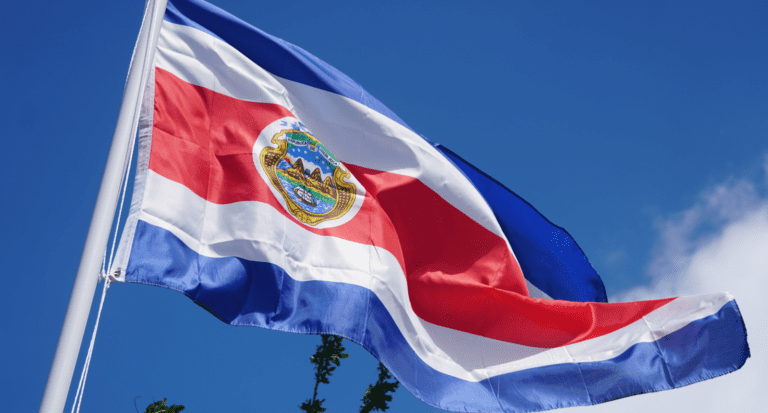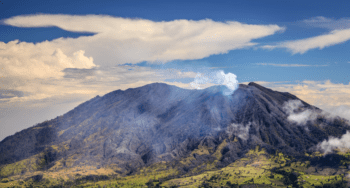Where is Costa Rica: What's Covered
Costa Rica is located in Central America, positioned between Nicaragua to the north and Panama to the south, forming a land bridge between North and South America with coastlines on both the Pacific Ocean (west) and Caribbean Sea (east). Despite common misconceptions that it’s in South America or the Caribbean, this small country of just 51,100 square kilometers sits on the isthmus connecting two continents, creating the perfect conditions for its incredible biodiversity. Having a rental car lets you explore from Pacific beaches to Caribbean shores in a single day – a unique advantage of Costa Rica’s narrow width.
Quick Facts:
- Central America consists of 7 countries, from Guatemala to Panama – Costa Rica sits right in the middle
- Juan Santamaría International Airport (SJO) near San José is the main gateway, not to be confused with San Jose, California
- Liberia Airport (LIR) serves the northwestern Guanacaste region
- Costa Rica spans just 200 miles at its widest point – you can drive coast to coast in under 6 hours
- The country abolished its army in 1949 and stands out from its war-torn regional reputation
Top 5 Geographic Features:
- Two Coastlines – 1,500 km of combined Pacific and Caribbean coastline offering completely different climates, cultures, and beach experiences
- Central Mountain Range – A volcanic spine running north-south creates 12 distinct microclimates despite the country’s small size
- Central Valley – Home to 70% of the population, including San José, sitting at 1,200 meters with year-round spring weather
- Guanacaste Province – Northwestern dry forest region with easy beach access from LIR
- Caribbean Lowlands – Unique Afro-Caribbean culture with canal systems replacing roads in places like Tortuguero
Costa Rica’s strategic location between two oceans and two continents explains why 5% of the world’s biodiversity exists in just 0.03% of Earth’s landmass – making it the ultimate eco-tourism destination.
If you need any help with a Costa Rica car rental, contact us now!
Costa Rica is an independent country in Central America, positioned between Nicaragua to the north and Panama to the south, with the Pacific Ocean to the west and the Caribbean Sea to the east. Located at 10°N latitude and 84°W longitude on the map of Costa Rica, this tropical nation sits roughly 1,100 miles from Miami—neither in South America nor technically North America, but part of the Central American isthmus connecting both continents. At 51,100 square kilometers, a Costa Rica map reveals a country similar in size to West Virginia, with San José as its capital and two international airports: Juan Santamaría Airport (SJO) near Alajuela and Daniel Oduber Quirós (LIR) serving Liberia and Guanacaste beaches like Tamarindo.
Key Takeaways
- Costa Rica is not in South America or North America—it’s in Central America between Nicaragua and Panama
- San José serves as the capital, with SJO airport in nearby Alajuela
- The Costa Rica flag features blue, white, and red stripes symbolizing sky, peace, and the blood of heroes
- Time in Costa Rica stays at CST (UTC-6) year-round with no daylight saving time
- Costa Rica’s weather divides into dry season (December-April) and green season (May-November)
- Costa Rica’s currency is the colón, but US dollars work everywhere tourists go
- Major destinations include La Fortuna, Manuel Antonio, Tamarindo, and Monteverde
- Costa Rica’s seven provinces (San José, Alajuela, Guanacaste, Puntarenas, Limón, Heredia, Cartago) each offer distinct experiences
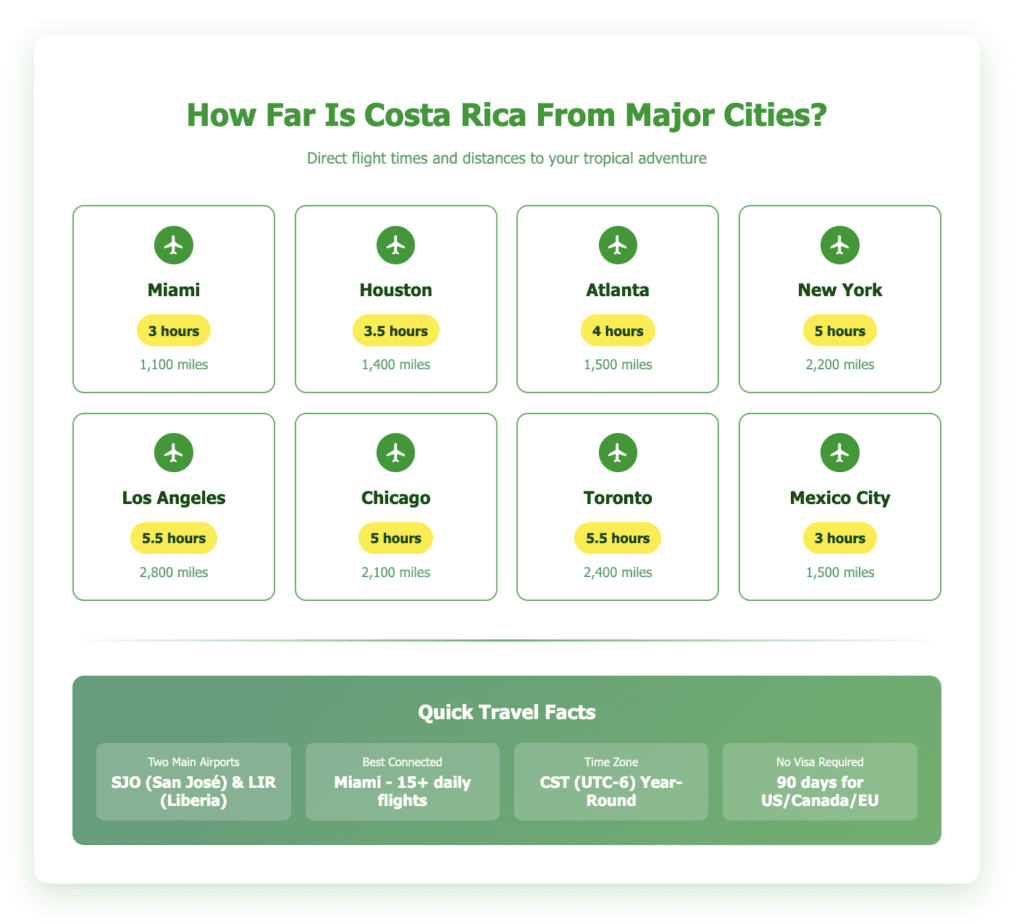
Is Costa Rica in South America or North America?
Neither—Costa Rica sits in Central America, though technically on the North American continental plate. When looking at a map of Costa Rica, you’ll see it’s part of the narrow isthmus connecting North and South America. This confuses many travelers who assume it must be in South America because of its Latin culture or North America because of its proximity to the United States.
Central America includes seven countries, and a Costa Rica map shows its strategic position in the middle: Guatemala, Belize, El Salvador, Honduras, Nicaragua, Costa Rica, and Panama. The region developed its own identity after independence from Spain in 1821, distinct enough to warrant classification separate from both massive continents it connects.
The geographic confusion makes sense when you consider that Costa Rica sits at the meeting point of four tectonic plates—the Cocos, Caribbean, Panama, and Nazca plates. This geological complexity creates the volcanic activity that shaped the country’s dramatic landscapes, from the active Arenal volcano near La Fortuna to the dormant peaks surrounding San José.
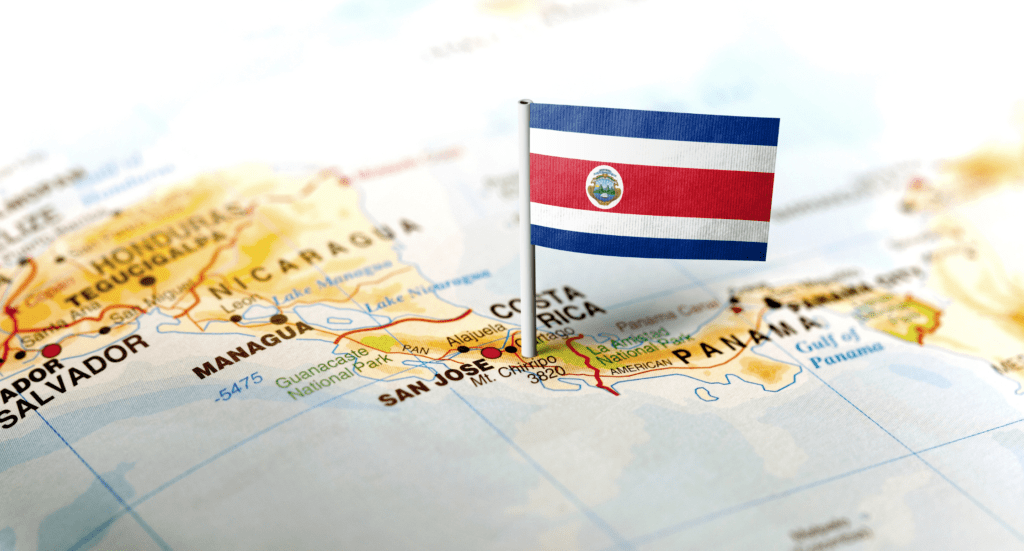
What Do the Costa Rica Flag Colors Represent?
The Costa Rica flag tells the country’s story through five horizontal stripes: blue-white-red-white-blue. The blue represents the sky, opportunities, and intellectual thinking that Ticos value. White symbolizes peace, wisdom, and happiness—fitting for a nation that abolished its military in 1948. The red stripe—double the width of others—honors the blood of those who died for Costa Rica’s freedom, plus the warmth and generosity of the Costa Rican people.
You’ll spot the Costa Rica flag everywhere, from government buildings in San José to small sodas in rural Puntarenas province. The coat of arms version, displayed on official buildings, adds imagery of three volcanoes representing the country’s volcanic spine, plus merchant ships on both the Caribbean and Pacific oceans, symbolizing Costa Rica’s commerce and openness to the world. The seven stars above represent Costa Rica’s seven provinces—San José, Alajuela, Heredia, Cartago, Guanacaste, Puntarenas, and Limón.
The flag’s design, adopted in 1848, coincided with Costa Rica’s emergence as a coffee-exporting nation. Today, when you see the Costa Rica flag at Juan Santamaría Airport or flying over hotels in Tamarindo, you’re seeing a symbol of Central America’s most stable democracy.
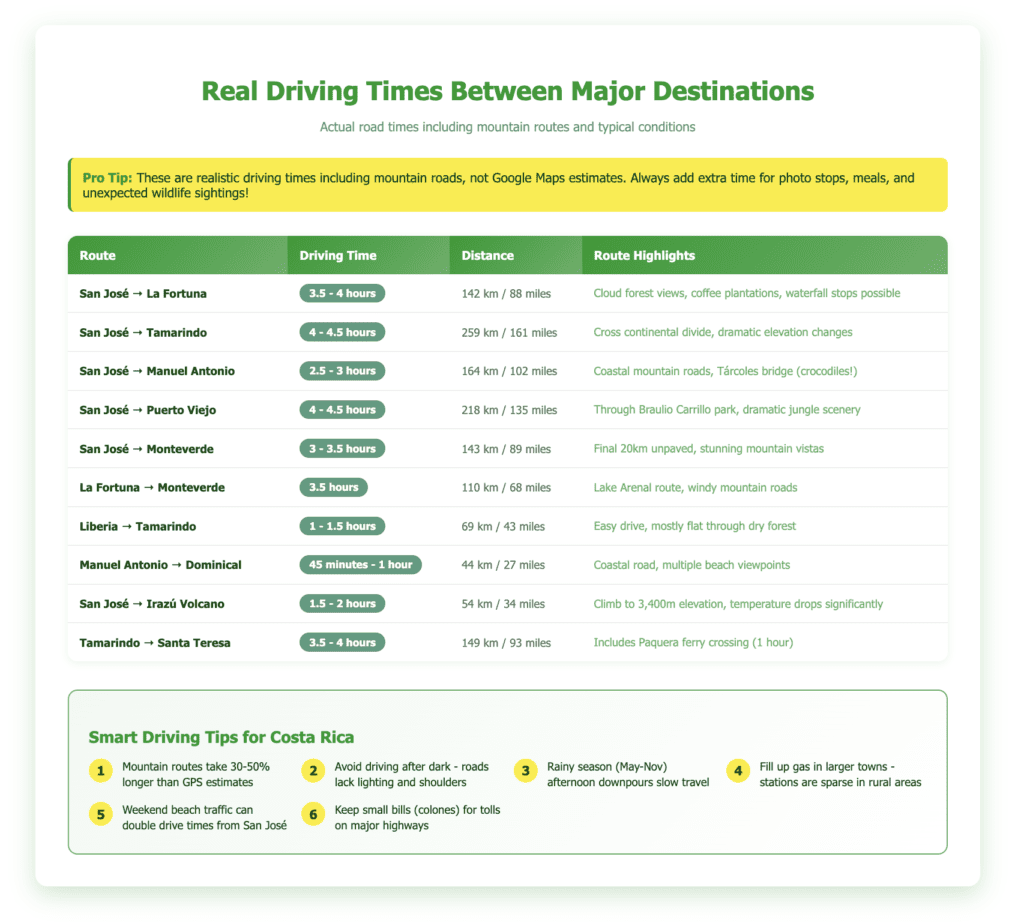
How Are Costa Rica’s Regions Organized?
Costa Rica is divided into seven provinces, each offering unique experiences and attractions. Looking at any detailed map of Costa Rica, you’ll notice how geography shapes these administrative regions:
San José Province contains the capital, San José, where nearly a third of the country’s population lives. The Central Valley location provides cooler temperatures than coastal areas, with elevations around 1,200 meters. Beyond the city, this province includes mountain towns, coffee plantations, and access routes to both coasts. Most visitors pass through San José when flying internationally, though few spend more than a night exploring its museums and markets.
Alajuela Province hosts Juan Santamaría Airport (SJO), making it most visitors’ first Costa Rican experience. The province stretches from the Central Valley to the Nicaraguan border, encompassing La Fortuna with its famous Arenal volcano and hot springs. Cloud forests blanket the mountains, while the lowlands near Los Chiles provide wetland bird watching. Alajuela city itself, just 20 minutes from the airport, offers authentic local experiences without tourist prices.
Guanacaste Province delivers what many picture when imagining Costa Rica—endless Pacific beaches with consistent surf and reliable sunshine. Liberia serves as the provincial capital and airport gateway (LIR), while beach towns like Tamarindo and Nosara attract everyone from backpackers to luxury travelers. This region sees the least rainfall, with some areas receiving under 1,500mm annually compared to 4,000mm in Caribbean zones. The dry tropical forest here differs completely from the rainforests elsewhere.
Puntarenas Province stretches like a finger along much of the Pacific coast, from the ferry port of Puntarenas city down to the Panama border. This diverse province includes the cloud forests of Monteverde, the popular beaches of Manuel Antonio and Jacó, and the remote wilderness of the Osa Peninsula. The variation within this single province showcases Costa Rica’s incredible geographic diversity—you can move from misty mountain forests to tropical beaches in under two hours.
Limón Province encompasses the entire Caribbean coast, culturally and climatically distinct from the rest of Costa Rica. Here, reggae music drifts from beachside bars, rice and beans come cooked in coconut milk, and English-based Patois mixes with Spanish. Puerto Viejo and Cahuita offer laid-back beach vibes, while Tortuguero requires boat access through jungle canals. The Caribbean side sees rain year-round, creating the lush green landscapes that define this region.
Heredia Province sits north of San José, climbing from the Central Valley into cloud forests and volcanic peaks. Barva volcano anchors the province, while coffee plantations carpet the hillsides. The university town of Heredia maintains colonial charm, and mountain villages like San Rafael offer cool climate escapes. Many birders base themselves here for easy access to varied elevations and their distinct species.
Cartago Province holds special significance as Costa Rica’s former capital and religious center. The basilica in Cartago city draws millions of pilgrims annually, while Irazú volcano—Costa Rica’s highest at 3,432 meters—offers views to both oceans on clear days. The Orosi Valley showcases colonial churches, coffee farms, and hot springs, providing cultural tourism away from beach crowds.
What Time Zone Is Costa Rica In?
Time in Costa Rica stays consistent year-round at Central Standard Time (CST/UTC-6), with no daylight saving changes. This simplifies travel planning but can confuse visitors whose home countries switch between summer and winter time. During the North American winter (November-March), Costa Rica time matches the US Central Time zones like Chicago and Houston. During the summer months, time in Costa Rica aligns with Mountain Time like Denver and Phoenix.
The lack of time changes reflects Costa Rica’s equatorial proximity—sitting at just 10 degrees north latitude means minimal seasonal daylight variation. Sunrise consistently occurs around 5:30 AM and sunset around 5:30 PM throughout the year, whether you’re watching from beaches in Tamarindo or mountains near San José. This predictability helps with activity planning—early morning wildlife tours make sense when animals are most active, while afternoon rains in the green season mean scheduling outdoor adventures before lunch.

How Does Costa Rica’s Weather Vary by Region?
Costa Rica’s weather patterns create dramatically different conditions across remarkably short distances. The country’s position between two oceans, combined with mountains reaching over 3,400 meters, generates twelve distinct climate zones despite the compact size visible on any Costa Rica map.
Guanacaste Province enjoys the driest conditions, practically guaranteeing sunshine from December through April. Tamarindo and nearby beaches see almost zero rainfall during these peak months, with temperatures consistently reaching 32°C (90°F). Even during the green season, mornings usually stay dry with predictable afternoon showers.
The Central Valley around San José maintains spring-like weather year-round due to elevation. Temperatures hover between 20-26°C (68-79°F), though mountain areas like Monteverde drop to 15°C (59°F) at night. The capital sees clear mornings even during the rainy season, with clouds building after lunch.
The Caribbean Region follows different patterns entirely. While the Pacific side dries out from December through April, the Caribbean often sees its driest weather in September and October—exactly when the Pacific gets drenched. Puerto Viejo and Cahuita stay humid year-round, creating the lush landscapes that define this coast.
The Northern Zone around La Fortuna and the Arenal volcano experiences the most rainfall, with some areas receiving over 4,500mm annually. Even in the “dry” season, afternoon showers remain common, feeding the hot springs and keeping rainforests vibrant green.
Understanding these regional variations helps plan realistic itineraries. That ambitious plan to drive from La Fortuna to Manuel Antonio might look reasonable on a map of Costa Rica, but afternoon rains can turn a 3-hour drive into a 5-hour adventure.

What’s Costa Rica’s Currency, and Can You Use US Dollars?
Costa Rica’s currency is the colón (plural: colones), named after Christopher Columbus (Cristóbal Colón in Spanish). Current exchange rates hover around 520-540 colones per US dollar, though rates fluctuate based on economic conditions. Bills come in denominations from 1,000 to 50,000 colones, featuring Costa Rica’s biodiversity—sloths, butterflies, sharks, and howler monkeys decorate the colorful notes.
US dollars work almost everywhere tourists visit, from hotels in Tamarindo to restaurants in San José. However, understanding the Costa Rica currency helps avoid confusion. When that beachside lunch costs “ten thousand,” they mean 10,000 colones—about $19, not ten thousand dollars. Most businesses calculate exchange at rounded rates (usually 500:1), slightly less favorable than banks but convenient for quick transactions.
Practical tips for handling money:
- ATMs at Juan Santamaría Airport and throughout cities dispense both currencies
- Credit cards work widely in tourist areas but not at sodas or fruit stands
- Small bills prove useful—breaking 50,000-colón notes challenges small vendors
- Tipping follows US customs (10-15% restaurants, $1-2 per bag for hotel staff)
- Always clarify whether prices are quoted in dollars or colones to avoid surprises
Which Airport Should You Choose for Costa Rica?
Your entry point significantly impacts your Costa Rica experience. Juan Santamaría Airport (SJO) in Alajuela province handles about 6 million annual passengers, offering more flight options and typically lower fares. Located 20 kilometers from San José, it positions you centrally for multi-region exploration. Choose SJO if visiting La Fortuna, the Caribbean coast, or southern Pacific destinations like Manuel Antonio.
Daniel Oduber Quirós International Airport in Liberia (LIR) has grown dramatically, now serving 1.5 million yearly visitors. This Guanacaste gateway puts you within 90 minutes of Tamarindo and other northwestern beaches. The smaller terminal means faster immigration processing, though fewer dining and shopping options while waiting.
Consider these factors when choosing:
- Flight schedules: SJO offers more red-eye returns to the US East Coast
- Seasonal service: LIR adds many routes from December through April
- Drive times: Calculate actual mountain driving, not straight-line distances
- Rental car availability: Both airports have Vamos Rentacar desks, but high season can mean limited vehicle selection at LIR
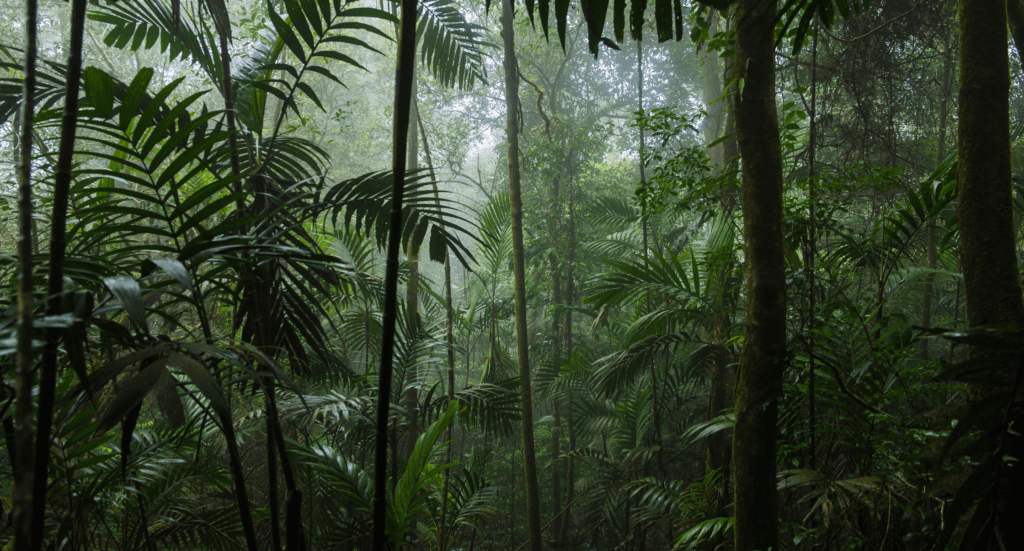
Why Does Costa Rica’s Location Create Such Biodiversity?
Costa Rica’s position as a biological bridge between North and South America creates extraordinary species diversity. When looking at a map of Costa Rica, you’re seeing where fauna and flora from two continents overlap, creating unique evolutionary conditions. The country hosts 5% of global biodiversity in just 0.03% of Earth’s surface—numbers that seem impossible until you experience the variety firsthand.
Elevation changes amplify this diversity. Drive from beaches near Puntarenas up to Monteverde, and you’ll pass through multiple life zones in two hours. Mangroves give way to dry forest, then premontane wet forest, finally reaching cloud forest at 1,400 meters. Each zone supports different species—scarlet macaws at sea level, resplendent quetzals in the clouds.
Having a rental car from Vamos lets you experience these transitions yourself. That drive from San José to the Caribbean crosses the continental divide, moving from Pacific-slope dry forests through cloud forest passes, descending into Atlantic-slope rainforest. It’s a biology lesson at highway speeds, showcasing why researchers flock here from worldwide universities.
Ready to Navigate Costa Rica’s Geographic Wonders?
Now that you understand where Costa Rica sits on the map—and how its unique position creates such incredible diversity—you’re ready to explore this Central American treasure. Whether entering through Juan Santamaría Airport near San José or via Liberia’s coastal gateway, you’re arriving at one of Earth’s most geographically blessed nations.
Pick up your Vamos rental car and discover why Costa Rica’s location between Nicaragua and Panama, straddling two oceans and bridging two continents, creates magic in such a compact space. From the dry forests of Guanacaste, where Tamarindo’s perfect waves break year-round, to the misty peaks of Monteverde, where clouds nurture impossible green forests, to the Caribbean beaches of Limó,n where howler monkeys serve as alarm clocks—every kilometer reveals why position matters.
That Costa Rica flag you’ll see everywhere reminds you this isn’t just another tropical destination. This is a country that chose conservation over exploitation, education over military spending, and sustainable tourism over quick profits. In a nation perfectly positioned at the crossroads of continents and oceans, where you can watch the sunrise over the Caribbean and sunset over the Pacific in the same day, those choices created something special.
The map of Costa Rica might show a small country, but don’t let size fool you. This is a place where geography creates possibilities—where volcanic soil grows world-class coffee, where elevation changes spawn cloud forests, where two oceans provide completely different beach experiences just hours apart. Understanding where Costa Rica is located is just the beginning. The real discovery comes when you explore how this perfect position between worlds created one of the planet’s most rewarding travel destinations.

Frequently Asked Questions
Can US Citizens Go to Costa Rica Now?
Yes, US citizens can enter Costa Rica without any special restrictions. You’ll need a valid passport (with at least 6 months validity remaining) and proof of exit within 90 days—typically your return flight ticket. No visa required for stays under 90 days. Costa Rica dropped all COVID-related entry requirements in 2022, so no vaccines or tests are needed. Just fly in, show your passport and return ticket at immigration, and you’re good to explore.
How Much Is $1 US in Costa Rica?
Currently, $1 US equals about 520-540 Costa Rican colones, though rates fluctuate. The practical news? You don’t need to exchange all your money—US dollars are accepted almost everywhere tourists go. Hotels, restaurants, tour operators, and even grocery stores in tourist areas take dollars. You’ll get change in colones, which works perfectly for smaller purchases. ATMs dispense both currencies, and credit cards work widely in tourist zones. Pro tip: bring some small US bills ($1s, $5s, $10s) for tips and small vendors who might struggle to make change for larger bills.
What Are the Best Months to Visit Costa Rica?
December through April offers the most reliable sunny weather—this is the dry season when rain is rare, especially in Guanacaste. But here’s the insider take: May through November (green season) brings afternoon showers that clear mornings for activities, plus you’ll find fewer crowds and rates drop 20-30%. The Caribbean coast actually flips this pattern, with September-October being its driest months. For the sweet spot of good weather and reasonable prices, consider late November or early May when the seasons transition.
Is Costa Rica Expensive?
Costa Rica costs more than other Central American countries but less than most Caribbean islands. Budget $50-80 per person daily for mid-range comfort (decent hotels, restaurant meals, some activities). You can spend less by eating at sodas (local restaurants), where a casado lunch runs $6-8, or more at luxury resorts. Activities add up quickly—zip lines cost $50-80, guided tours $60-150. Having a rental car saves money on expensive transfers between destinations. The biggest surprise? Groceries cost similar to US prices, sometimes more for imported items.
Can You Drink the Water in Costa Rica?
Yes, tap water is safe to drink throughout most of Costa Rica—it’s one of the few Latin American countries where you can fill your bottle from the tap without worry. The water treatment infrastructure is excellent in cities and most tourist areas. Some remote coastal areas or rural locations might have questionable water quality, but hotels in these areas provide filtered water. Ice in restaurants is safe, as is brushing your teeth with tap water. If you have a sensitive stomach, bottled water costs about $1-2 and is available everywhere.
What Should You Be Careful of in Costa Rica?
Costa Rica is generally safe, but stay alert for these common issues: Don’t leave valuables visible in rental cars—break-ins at isolated beaches or trailheads happen. Riptides are the biggest danger at many Pacific beaches—swim near lifeguards when possible and never fight a rip current (swim parallel to shore instead). The sun is intense year-round; you’ll burn quickly even on cloudy days. Drive defensively—roads can be narrow with no shoulders, and afternoon rains make surfaces slick. Skip swimming in rivers unless locals confirm it’s safe—crocodiles inhabit many lowland waterways.
Do I Need Malaria Pills for Costa Rica?
No, malaria medication isn’t necessary for Costa Rica. The country has been essentially malaria-free for years, with only rare cases in remote border areas that tourists never visit. You’ll want insect repellent for mosquitoes that can carry dengue (mostly in lowland areas during the rainy season), but malaria isn’t a concern. Focus instead on sun protection, staying hydrated, and perhaps bringing anti-diarrheal medication just in case. Most travelers experience no health issues beyond occasional traveler’s stomach from trying new foods or too much tropical fruit.
